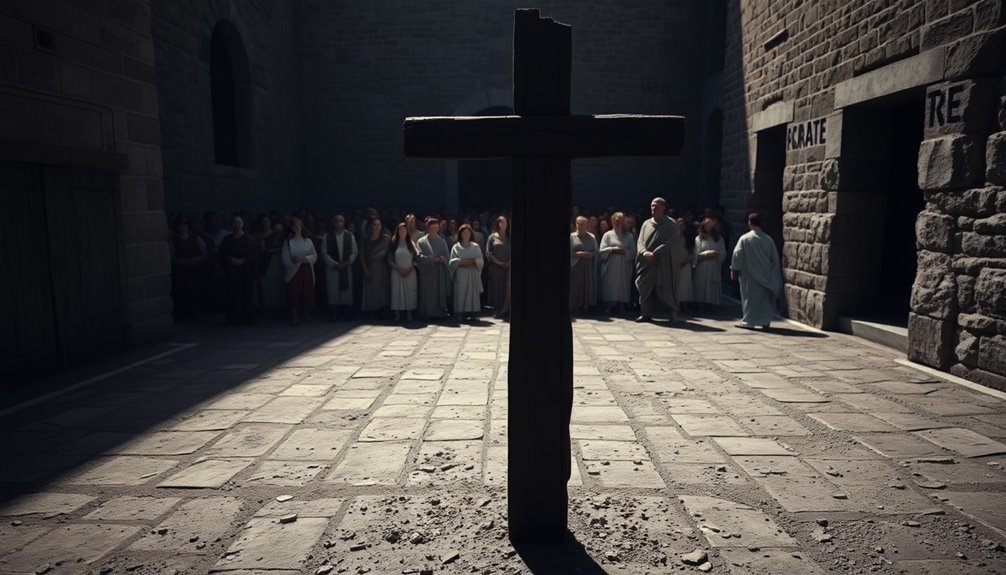Paulo died by decapitation during Emperor Nero's reign, a time of intense persecution for Christians. As a Roman citizen, he was spared from brutal execution methods like crucifixion, which was a reflection of both his status and the legal protections that came with it. His martyrdom occurred amidst rising oppression and chaos following the Great Fire of Rome. Paulo faced his fate with unwavering faith, as captured in his writings. His legacy continues to inspire many in the Christian community today. You might find it intriguing to explore the circumstances surrounding his courageous final moments.
Key Takeaways
- Paulo was executed during Nero's reign, around 64 AD, amid severe persecution of Christians in Rome.
- He was a Roman citizen, which allowed him to be beheaded rather than subjected to more brutal execution methods.
- Tradition holds that he was decapitated near Rome, symbolizing his status and the honor of his death.
- His execution was politically motivated, as Nero sought scapegoats after the Great Fire of Rome.
- Paulo's martyrdom exemplified his unwavering faith, inspiring early Christians to remain steadfast amidst adversity.
Introduction

In understanding how Paulo died, it's essential to consider the historical context surrounding his execution.
As an apóstolo do cristianismo, Paulo enfrentou uma severa perseguição durante o reinado de Nero, que começou por volta de 64 d.C. A tradição cristã sustenta que ele foi decapitado, um método de execução que reflete seu status de cidadão romano, isento de crucificação. Essa execução provavelmente ocorreu nas proximidades de Roma, onde a opressão contra os cristãos estava em seu auge.
Paulo, ao se preparar para sua morte, expressou em 2 Timóteo 4:6-8 sua certeza de que uma recompensa o aguardava. Essa passagem destaca não apenas sua iminente morte, mas também sua determinação e fé inabalável.
O martírio de Paulo não é apenas um relato de sua morte; ele solidificou sua figura como um dos principais mártires do cristianismo primitivo. A maneira como Paulo enfrentou sua morte inspirou muitos cristãos, tornando sua história uma parte vital da tradição que continua a influenciar a fé cristã até hoje.
Scriptural Insights on Martyrdom

When you consider the scriptural insights on martyrdom, Paul's situation provides profound lessons.
References like 2 Timothy 4:6-8 highlight his awareness of the impending sacrifice he faced, while early church accounts add context to his ultimate fate.
Analyzing these biblical passages can deepen your understanding of what it truly means to stand firm in faith, even unto death.
Primary Bible References
Martyrdom, a powerful theme in Christian teachings, finds significant reflection in the life of the Apostle Paul. Although the Bíblia não diz como Paulo foi executado, 2 Timóteo 4:6-8 provides insight into his mindset as he faced imminent death. He described his life as "being poured out as a drink offering," indicating a readiness for sacrifice.
Paul emphasized that he'd "fought the good fight" and had a "crown of righteousness" awaiting him, showcasing his unwavering faith.
Acts dos Apóstolos highlights Paul's determination to endure suffering for Christ. His readiness to face the morte de martírio de exemplifica his commitment to spreading the Gospel. Early church tradition, particularly from Eusebius, claims that Paul was beheaded under the orders of imperador Nero, marking the culmination of his evangelistic efforts.
While the exact circumstances of the apóstolo Paulo's death remain unclear, his legacy endures through his teachings and sacrifices.
Paul's final moments were likely spent proclaiming the truths of Christianity, reflecting the deep conviction that characterized his life. His martyrdom serves as a powerful testament to his faith and dedication.
Secondary Bible References
Paul's life and teachings reflect a profound understanding of suffering for faith, and several secondary Bible references illuminate this theme. In 2 Timothy 4:6-8, Paulo foi aware of his impending death, describing himself as "poured out as a drink offering." This acknowledgment shows his readiness to face his fate, which history tells us was tied to the intense persecution of Christians under Emperor Nero after the Great Fire of Rome in 64 AD.
Eusebius notes that o apóstolo Paulo morreu by being beheaded, a method befitting his status as a cidadão romano, which spared him from being crucificado de cabeça para baixo.
Acts 21:13 also highlights Paulo's unwavering commitment to Christ, as he expressed his willingness to die for the Gospel. His letters, like Philippians 1:29, emphasize the importance of suffering for faith, establishing a theological foundation for understanding martyrdom's significance in early Christianity.
Ultimately, Paulo era not just a martyr but a testament to the faith he lived and preached, inspiring countless others to endure hardships for the sake of the Gospel.
Roman Execution Practices

Throughout history, Roman execution practices have varied widely, reflecting the legal status and crimes of the condemned. For instance, beheading was deemed a more honorable form of execution, typically reserved for Roman citizens. In contrast, crucifixion was a common punishment for non-citizens and slaves, serving as a brutal reminder of the consequences of defying authority. If Paul was executed as a Roman citizen, it likely involved beheading, which provided a swift execution compared to the prolonged suffering of crucifixion.
Execution practices also required the presence of a public official or executioner, ensuring the process adhered to legal protocols. The condemned often had the opportunity to make a final statement, which allowed them to express their thoughts or appeals before meeting their fate.
Public executions played a crucial role in Roman society, acting as a deterrence mechanism against crime. They reinforced the power of the state and demonstrated the severe consequences of disobedience. By witnessing the executions, citizens were reminded of the legal status they held and the repercussions of crossing the Roman Empire.
Causas Da Execução Romana

A execução de Paulo foi influenciada por uma combinação de fatores políticos e sociais que caracterizavam a Roma antiga. Durante o reinado de Nero, a busca por um bode expiatório após o Grande Incêndio de Roma em 64 d.C. fez com que o imperador visse os cristãos como alvos ideais. A fé inabalável de Paulo no cristianismo e sua liderança na propagação dessa nova religião tornaram-no um alvo específico.
Após ser preso, Paulo enfrentou a condenação à morte, evidenciando a crescente perseguição aos seguidores de Cristo. A tradição cristã sugere que, como cidadão romano, ele teve o privilégio de uma execução menos brutal, resultando na decapitação em vez da crucificação, uma prática comum entre os não-cidadãos.
Essa escolha refletia tanto a sua posição social quanto a brutalidade do sistema romano, que frequentemente usava a tortura e a execução como formas de controle.
Assim, a execução de Paulo não foi apenas uma tragédia pessoal, mas também um símbolo da repressão que os cristãos enfrentavam em Roma, um lembrete do preço de sua fé em tempos de perseguição.
Paulo's Citizenship Status

When you think about Paulo's citizenship status, it's crucial to set the record straight on some common misconceptions.
Many people overlook how his Roman citizenship shaped his legal rights and protections, especially regarding punishment and trial.
Understanding this context not only clarifies historical accuracy but also highlights the significance of his status in his life and death.
Debunk Common Misconceptions
Many people mistakenly believe that Paul's citizenship didn't significantly impact his life and ministry. However, being a cidadão romano provided Paulo with crucial legal protections. Unlike many non-citizens who faced brutal executions, such as crucifixion, Paulo was decapitado, a method reserved for Roman citizens. This distinction highlights the privileges he enjoyed, even under the tyranny of Nero.
In Atos 25:11, we see Paulo exercising his rights by appealing to Caesar, showcasing how his citizenship allowed him to navigate the Roman legal system effectively. His dual identity as a Jew and a Roman citizen was vital for his missionary work, enabling him to connect with both Jewish and Gentile audiences throughout his vida de Paulo.
While some might think citizenship played a minor role in his ministry, the truth is that it shaped his experiences profoundly.
It's important to recognize that Paulo's execution wasn't just a random act of violence; it was a decision influenced by the political landscape of the time. Understanding this aspect of his life helps clarify the complexities surrounding his legacy as an apóstolo and a prominent figure in early Christianity.
Historical Accuracy Concerns
Understanding the nuances of Paul's citizenship status is vital for grasping the historical accuracy surrounding his life and death. As a Roman citizen, Paulo enjoyed specific rights that greatly impacted his fate, particularly during his execution. Unlike many non-citizens who faced crucifixion, a brutal form of punishment, he was decapitado, a method considered more humane and dignified.
This citizenship not only provided legal protections but also allowed Paulo to appeal to Caesar, showcasing the importance of his rights within the Roman legal system. The implications of his cidadania illustrate the social dynamics of Roma, where legal status influenced an individual's treatment, especially in matters of life and death.
When comparing Paulo's martyrdom to that of other apostles, like Pedro, the variations in their executions raise concerns about historical accuracy. The differing accounts of their deaths reflect the complexities surrounding their statuses as citizens.
In understanding these distinctions, you can appreciate how Paulo's execution and the nature of his martírio were shaped by the rights afforded to him, marking a significant point in early Christian history.
Faith During Persecution

When you think about Paul's experiences, it's clear that courage in the face of adversity is vital for maintaining faith.
His unwavering belief not only inspired him but also strengthened the Christian community around him.
Together, they showed how resilience can flourish even amid persecution.
Courage in Facing Adversity
Courage in facing adversity often reveals the true strength of one's faith, and Paul exemplified this through his unwavering commitment to Christ despite relentless persecution. Throughout his ministry, Paulo encountered significant challenges, including imprisonment and the constant threat of martyrdom. His bold declaration of the evangelho, even when warned of impending suffering (Acts 21:13), showcases his remarkable coragem.
Even during his second Roman incarceration under Emperor Nero, Paul remained steadfast. He continued to spread the message of Christ, writing letters filled with hope and encouragement, particularly in his final correspondence to Timothy.
Paul understood that adversity was intertwined with his calling, as Jesus foretold the tribulations he'd face for His name (Acts 9:16).
Embracing this understanding, Paulo faced his eventual martírio with unwavering faith. The lengths he went to, even knowing the dangers ahead, illustrate the essence of true courage.
His life serves as a powerful reminder that facing persecution doesn't diminish one's faith; instead, it can amplify it. In the face of adversity, Paul's example urges you to stand firm in your beliefs, no matter the cost.
Faith-Based Community Resilience
Paul's unwavering faith not only inspired him but also fortified the early Christian community during times of intense persecution. Under Emperor Nero, Christians faced severe challenges as they were scapegoated for the great fire of Rome in 64 AD. This led to brutal executions, yet the resilience of the church shone through.
You can see how these early believers, despite the threat of martyrdom, continued to spread the evangelho and establish new igrejas.
In his letters, Paulo emphasized the importance of faith and perseverance, urging believers to remain steadfast against persecution. His teachings served as a beacon of hope that encouraged many to hold onto their fé, even when faced with the possibility of suffering.
The martyrdom of Paul and other apóstolos galvanized the community, inspiring future generations to uphold their beliefs despite personal risk.
Together, they united in their shared convictions, creating a support network that fostered strength and resilience.
The early church's growth amidst adversity showcases the incredible power of faith, proving that even in the darkest times, hope can flourish when believers stand together.
Legacy of Paul's Martyrdom

Throughout history, Paul's martyrdom has consistently inspired countless Christians, serving as a powerful symbol of faith and sacrifice. Believed to have occurred around 67 AD during the fierce persecution under Emperor Nero, Paulo's death marked a significant moment for the early church. His beheading, a result of his Roman citizenship, spared him from the brutalities of crucifixion, yet it exemplified the ultimate commitment to his beliefs.
This martírio not only solidified Paulo's status as a pivotal figure in Christianity but also reinforced the idea that true fé often requires profound sacrifice. As he wrote in 2 Timothy 4:7, he "fought the good fight," which resonates deeply with many cristãos today.
His legacy has influenced theological thought and shaped the moral framework of the igreja, inspiring believers to uphold their convictions, even in the face of adversity.
Paul's unwavering commitment to spreading the teachings of Christ continues to motivate individuals seeking to live authentically in their faith. His life and death serve as a reminder that one's commitment to a cause can leave an indelible mark on history, encouraging others to follow in his footsteps.
Additional Resources

To further explore the profound impact of Paul's martyrdom and the teachings he left behind, there are numerous resources available for those interested in deepening their understanding.
Books such as "The Apostle Paul: His Life and Letters" offer insights into how Paulo foi um mártir, detailing the historical context of his death in Roma. You can also read Eusebius' works, where he describes the circumstances surrounding Paul's beheading under Emperor Nero, providing a vivid account of the trials faced by early cristãos.
Additionally, examining the early church's writings will shed light on how the apostólo Pedro's crucifixion contrasts with Paul's execution, highlighting the different paths of these foundational figures.
Online courses and lectures focused on early Christian history can enrich your perspective on how Paulo's legacy shaped Christian doctrine and inspired future generations.
Lastly, engaging with scholarly articles will help you understand the broader implications of martyrdom in Christianity and how these events influenced the resilience of the faith.
Frequently Asked Questions
How Was the Death of the Apostle Paul?
The death of the Apostle Paul is believed to have been a martyrdom, reflecting his unwavering faith.
You'll find that he was likely executed by beheading during Emperor Nero's persecution of Christians. As a Roman citizen, he wasn't subjected to crucifixion, which made this method of execution less brutal.
While the exact details remain unclear, his letters and teachings have had a profound impact on Christianity, shaping its doctrine for centuries.
Why Was Paul Decapitated?
Paul was decapitated because, as a Roman citizen, he was granted a more dignified execution method compared to crucifixion.
This choice reflected the brutal reality of persecution against Christians during Nero's reign.
You'll see that his beheading symbolized his unwavering faith and commitment to his beliefs, even in the face of death.
It highlights the severe consequences faced by early Christians for their beliefs during a tumultuous period in history.
How Did Paul Die in the Bible Verse?
In the Bible, Paul's death isn't described in detail, but you can find insights in 2 Timothy 4:6-8.
There, he reflects on his life, expressing readiness to face death and viewing it as a sacrifice for his faith.
While the exact manner of his death isn't specified, you'll see that he considers his impending demise as the culmination of his unwavering commitment to Christ and the fight he's led throughout his ministry.
How Old Was the Apostle Paul When He Died?
You'd find that the Apostle Paul was likely between 59 and 62 years old when he died.
He was born around 5 AD and is believed to have died around 64-67 AD.
While historical records are sparse, this estimation gives you a glimpse into his life span during a significant period of early Christianity.
His age at death remains a topic of discussion, but these dates are generally accepted among scholars.










